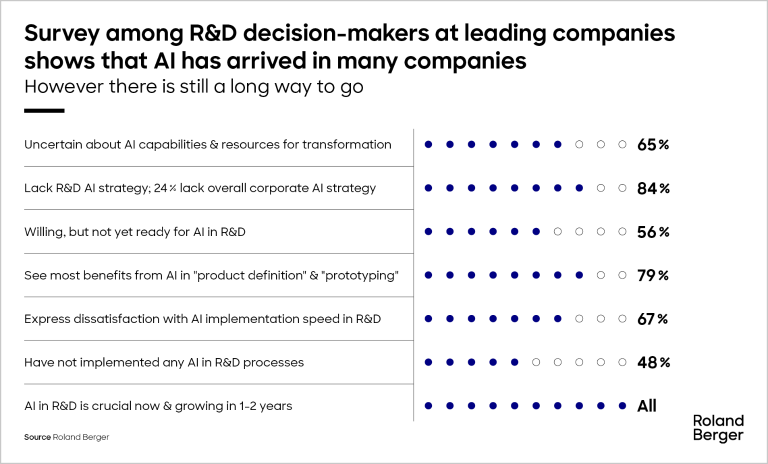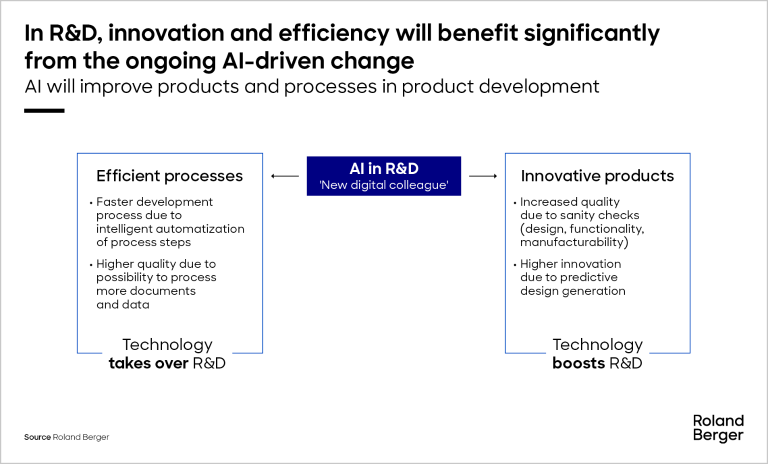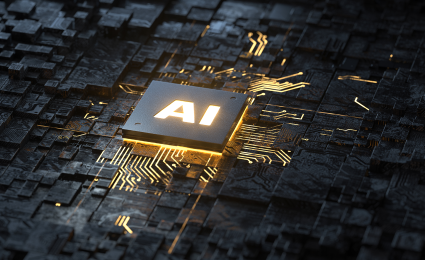Hopes are high for generative AI. It is expected to do nothing less than resolve the productivity crisis in advanced economies. A new study by Roland Berger shows that these hopes are well founded. If properly applied, language models like ChatGPT can open up completely new possibilities for increasing productivity – such as by taking over routine back-office tasks or helping people with complex parts of their job as a digital co-worker.


Unleashing the power of AI in R&D
By Julia Duwe and Kay Thielemann
AI in R&D will lead to more innovative products and efficient processes - but there is still a long way to go.
Artificial Intelligence (AI) is a transformative force with profound implications for R&D, permanently changing products and processes. Companies must adapt to this development to keep pace with their competitors and ensure their future success. A recent Roland Berger survey among R&D decision-makers finds AI in R&D as a game changer with the highest relevance now but also for the mid-term future.

"AI will lead to significant changes in R&D: It will boost productivity and facilitate the development of more innovative products and solutions"
However, despite recognizing the importance of AI, 84% of companies do not have an R&D AI strategy, according to the survey. The main barriers include a lack of understanding, fear of the unknown, and a lack of expertise and resources, with 65% of company representatives unsure about the AI capabilities and resources needed for transformation. A similar number (67%) expressed dissatisfaction with the speed of AI implementation in their R&D department, and 48% have not yet implemented AI in R&D processes.
Despite the uncertainty, one thing is clear: AI will lead to significant changes in R&D departments, with the potential to boost productivityand create more innovative products and solutions. Emerging use cases of AI in R&D, such as generative design, patent screening, and change-impact management, could reduce product development time by more than 60% in the next one to two years. In addition, companies will benefit from an increase in the number of patents filed, lower prototyping costs, reduced CO2 emissions, and more.
AI in R&D: an opportunity for products, processes, and people
The survey results underscore the key role of AI in R&D, revealing a wide range of opportunities for products, processes, and people. In particular, R&D leaders highlight how AI is not only driving efficiency, but also fostering innovation among employees. Respondents point to a shift toward more collaborative and forward-thinking work environments as AI becomes an integral part of the R&D landscape. Companies using AI in R&D will not only experience accelerated innovation but will also reap benefits such as up to 25% lower costs and more than 35% improved FTE efficiency.
Important action areas toward AI implementation
To implement AI in R&D we highlight five action areas that will guide organizations through a systematic and transformative journey:
- R&D AI strategy
For AI to truly thrive in R&D, it must be aligned with a clear value proposition and the organization's broader data and AI strategy. Selecting a well-defined AI value proposition is essential for the focused implementation of AI initiatives. This includes defining the level of ambition, setting target KPIs, identifying value drivers, and assessing business returns. Crucially, the AI value proposition should challenge the traditional scope of R&D within the organization. This means re-evaluating and expanding the role of R&D in driving value across the organization, rather than viewing it in isolation. - Application definition
Specifying use case definitions is important to bring the broader AI vision and ambition to life. The generic R&D process, along with its associated strategy and governance, serves as a foundational guide to ensure that use cases align with strategic goals like achieving faster time-to-market. Guided by principles such as maturity, technology understanding, and expected impact or value, organizations can systematically identify and prioritize use cases along the R&D process. Based on our extensive project experience, we have identified more than 50 use cases, which are mainly concentrated along central R&D steps such as requirement management and prototyping & testing, but also focus, for example, on strategy development or governance. - Partner ecosystem
In addition to choosing the right technologies, organizations need to build a strong ecosystem of partners and specialists to facilitate this transformation. Home-grown AI solutions may be at risk of being overtaken by the competition, underscoring the importance of working with external experts. Companies must create specialized structures to harness the full potential of their ecosystems and effectively orchestrate interfaces to drive innovation. - Process and organizational redesign
Organizational structures must be individually adapted to the company's characteristics, strategy, and specific use cases for AI. Organizational transformation becomes strategic, creating an environment that fosters the efficient integration and operation of data and AI technologies. The process involves a comprehensive assessment of existing workflows, roles, and responsibilities to ensure they complement and maximize the benefits of data and AI adoption. By embracing organizational transformation, companies can create agile structures that seamlessly accommodate the transformative impact of AI and foster a culture that encourages innovation and collaboration across departments. - Human capital upskilling
AI transformation goes beyond the adoption of new technologies; it involves a broad socio-ecological shift. This holistic shift affects not only technology, but also the way organizations operate. By leveraging AI, companies can improve their products and drive innovation while improving internal processes and their efficiency. As AI takes over simple and monotonous tasks, employees will have more capacity to unleash their creative potential. Simply put, AI can empower R&D teams to think and create on a whole new level.
Unlock the potential of AI in R&D
AI is driving transformational change in R&D, improving product innovation and internal processes. It is unlocking new levels of creativity and redefining the role of R&D within organizations. Our five highlighted areas provide guidance for companies to strategically leverage AI and undertake a comprehensive transformation that aligns with their unique R&D landscape and goals. From defining the AI vision to upskilling human capital, companies can systematically identify and prioritize use cases, build a strong partner ecosystem, redesign processes and organization, and foster a culture of innovation and collaboration.
While the technologies are still in their infancy and not all companies have begun to unlock the potential of AI, it is important to take a close look at the topic today and define a strategy for your company to benefit from the AI transformation.
To dive into AI and leverage the insights for your business, we offer a free two-hour workshop tailored to your needs. Contact our AI and operations experts to schedule your slot.
We would like to thank David Herberger for co-authoring this article.













